|
In climatology, record-breaking is of little significance climatically speaking. An all-time hot record in one place can be easily matched by an all-time
cold record somewhere else. This year in the U.S. and in Australia, both hot and cold records have been broken at various times and places. They make interesting fare for the Guinness Book of Records, but little else.
However, record-breaking does have one purpose for the greenhouse industry, namely that of heightening public fears about
global warming. For this reason, the industry likes to see hot records being broken as often as possible, present a lot of media hype about them, and then go into quick denial and spin-making when cold records are broken, sometimes even blaming the cold record on global warming!
The industry also dislikes a hot record being very old, such as the all-time hot daytime record for Australia
of 53.1°C. set at Cloncurry, Queensland in 1889. Valuable research money and academic effort was spent in a futile effort to discredit that one record
(Trewin, B., Aust.
Met. Mag. 46 (1997) 251-256).
There is one all-time hot record that is the ultimate global prize: 58°C
(136°F) set at Al Aziziya, Libya, in 1922. This was the hottest temperature ever recorded anywhere in the world and has stood for
80 years in spite of real or imagined `global warming".
It is even noted in the Guinness Book of Records. But 1922 is a long time ago and the longer it stands, the less convincing are the claims about global warming in the eyes of the public.
To topple this record, the industry has not bothered with the Cloncurry approach - that of seeking to discredit the record itself - as that appeared to be, and was,
merely sour grapes and spin.
|
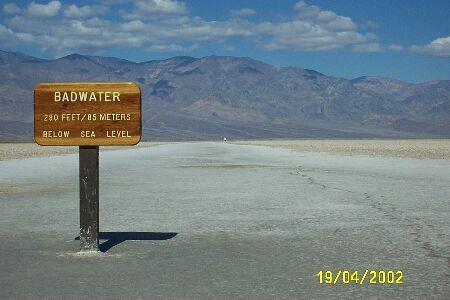
Fig.1 - Badwater
|
Instead,
the NASA Ames Research Center (ARC), has set up their own temperature instrument in
Death Valley, even though there is already a long-standing instrument
at Furnace Creek right in the open central part of the valley.
The new instrument is located 20
miles south of Furnace Creek at Badwater (Fig.1).
The photo shows the Badwater area
with a large salt pan stretching into the far distance, caused
by evaporation of salty water welling up from a spring just
metres this side of the sign shown in the photo. |
|
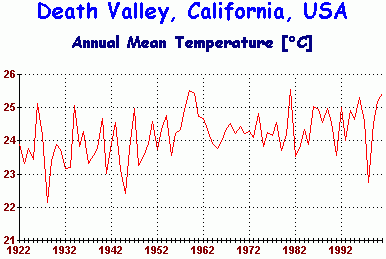
Fig.2 - GISS Historical Data for Furnace Creek
|
It was
at Furnace Creek that the all-time hottest record in the USA was broken,
57°C. ( 134°F.) in 1913,
just 2°F short of the Libyan all-time record.
The GISS
historical data for Death Valley (i.e.
Furnace Creek) is presented left and shows no overall warming at Death Valley since the
1950s.
The new instrument at Badwater
was installed in the late 1990s, but it must be
stressed that the record left is for Furnace Creek, not Badwater.
Yet the public plaque on the instrument at Badwater implies
otherwise. |
|
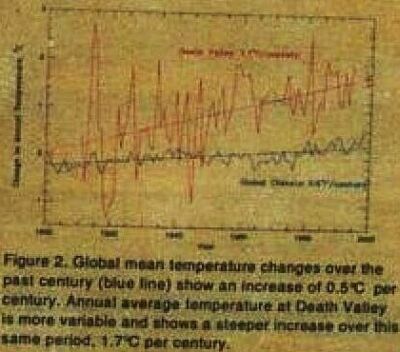
Fig.3 - Part of the Badwater Plaque
|
Here is how the public plaque at
Badwater misrepresents Death Valley (Fig.3).
It's red graph line traces the same data as the one above, and
it is immediately clear that the ARC graph differs from GISS in
that the ARC graph shows a continuous warming whereas the GISS
graph only shows warming pre-1950s with little long-term change
since. They can't both be right. The plaque also said -
"During the
summer of 1998 - the warmest year on record - we recorded the hottest
air temperature anywhere in the world of 53.06°C ±0.1°C (128°F) on
17 July 1998 at 3:15 pm local standard time."
Having mentioned
1998, that year was conveniently left off the chart. And
with good reason, as Fig.2 shows that 1998 was a particularly
cool year. |
|
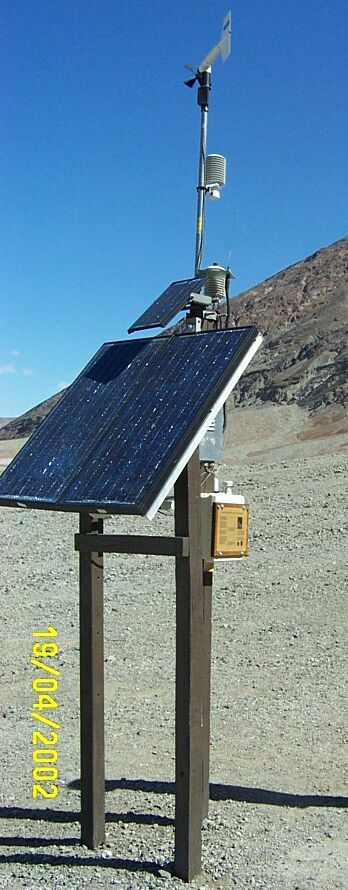
Fig.4 - The Badwater instrument.
|
What exactly do
those skilfully crafted words on the plaque mean anyway? Note, it refers to 1998 as the
`warmest
year on record', but omits to say they are referring to the world as
whole, not to Death Valley itself. 1998 at Death Valley
(Furnace Creek) was
actually cooler than usual.
The plaque claims Death
Valley recorded the hottest air temperature anywhere in the world on
17th July 1998 - implying it was an all-time world record. It was
not. It was referring to
1998 only. Actually, the hottest
temperature ever recorded at Death Valley was way back in 1913 on 10th
July - a whopping 134°F
(57°C).
The sharp dip in temperature near the end of the record (Fig.2) was - 1998 !
- the `warmest year on record' according to the plaque. In fact, 1998 was the
coolest
year at Death Valley since 1945, belying the implied claims about 1998.
Note how the ARC plaque refers to `Death
Valley' generally and not Badwater or Furnace Creek specifically.
This merging of two quite different locations 20 miles apart is itself
misleading to the public who may be unaware that `Death Valley' now has
more than one weather station.
A photo of the weather instrument at Badwater is shown left, the small yellow plaque mounted low down on the
structure. I visited there during my trip in April this year.
Unlike the Furnace Creek instrument which is located in the open centre of the big valley, the new instrument has been mounted next to the eastern
side of the valley at Badwater. The local topography is such that the instrument sits in a curved hollow (topographical map - Fig.5) so that it is well sheltered from all but westerly winds,
and fully exposed to the afternoon summer sun. In fact, the whole
area around the instrument is a perfect afternoon sun trap.
On the east side of the instrument is a high west-facing cliff over 500 feet tall, a cliff which will heat up magnificently in the afternoon sun on a hot summer's day. 280 feet up on that cliff is a large sign which says
`mean sea level' (Badwater is 285 feet below sea
level).
|
|
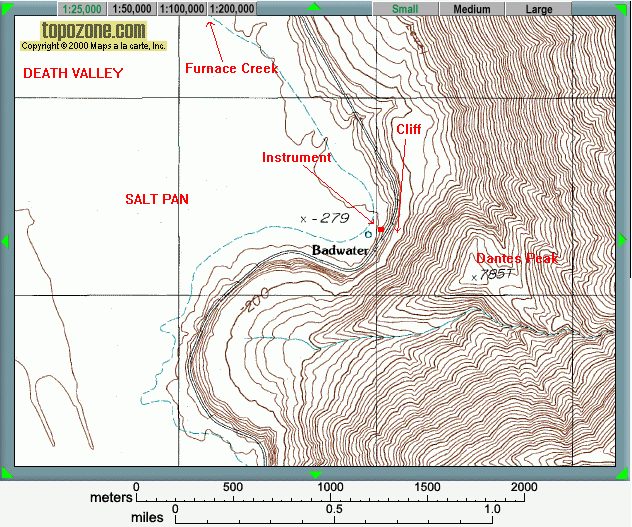
Fig.5 - Topographical Map of the Badwater area
|
Rising steeply above the cliff is the aptly named
Dantes Peak, 785 feet high, overlooking what must be the nearest thing to `Dante's Hell' on Earth - Badwater in Death
Valley.
On the western side of the instrument is a vast white salt pan, caused by salt deposits from a spring bubbling up from underground
(the `bad water') (Fig.1&6). This salt pan has a high albedo to sunlight so that the afternoon sun will reflect light and heat off the white expanse directly onto the cliff and the instrument itself.
On a bright afternoon, it will act almost like a mirror to sunlight.
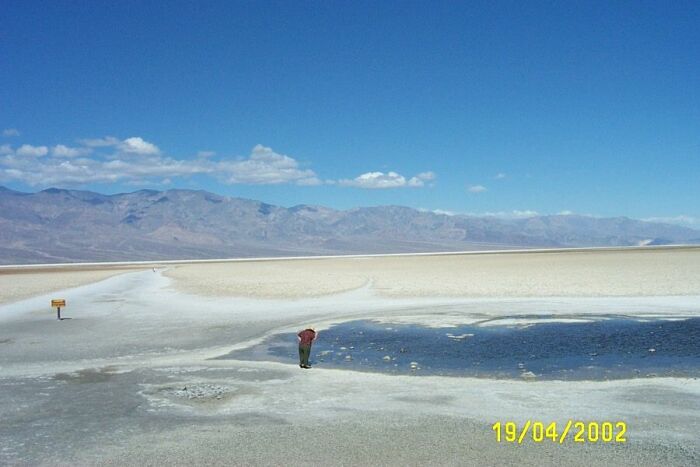
Fig.6 - The vast salt pan and salty spring directly to the west of the instrument
In all of Death Valley, the
ARC has chosen just about the hottest spot possible in the hottest valley in North America. They have in effect
put it into a natural oven - and done so in the full knowledge of
Badwater's topography. Now all they have to do is wait - wait for the inevitable day when the conditions will be just right - clear skies, still air, a blazing sun, and that instrument will heat up from the combined heating of the air, the
immense heating from the nearby cliff only metres behind the instrument, the
intense reflected heat radiation from the salt pan, and the mercury will very likely fall over the Libyan line and record the
`hottest temperature ever measured on earth'.
Then we will see the champagne corks fly as the greenhouse industry will
cry with righteous indignation, announcing the `new hottest temperature ever recorded on
earth', how it's all due to global warming etc. etc. and all the time, the whole thing will be about as fake as a
three dollar bill.
Even the wording on the plaque on the instrument betrays the real intent
- the exclusive emphasis on the significance of heat, of global warming,
of record-breaking temperatures, of the `hottest year ever'
etc. The plaque speaks of little else. Even the
opening words of the text are `Carbon dioxide
released by human activities etc. ....'. Consequently, it is
reasonable to conclude that record-breaking is the primary purpose of the
instrument, not genuine climatic research.

Fig.7 - The full information contained on the public plaque
This is further suggested by
The Ames
Astrogram, February 7,
2000, Page 2, who reported on a field trip by some of its scientists
to Death Valley, (among them Dr Chris McKay who is
cited on the plaque), and made this reference to the Badwater
weather station - "The next stop was Badwater
-- minus284 feet below sea level, the lowest point in North America.
McKay checked on a weather station he had installed at Badwater two years ago to precisely measure the temperature changes there and monitor global
warming -- which is much more noticeable in an extremely hot environment like Death Valley.
In1999, McKay's weather station recorded the continent's highest temperature -- a
toasty 53.01 C."
Even here, we have the focus
squarely on global warming and breaking records just as on the plaque. ARC even reports the breaking of
a continental record. If the Libyan world record of 1922 is
broken, as seems inevitable at Badwater eventually, we can expect the
full media scare treatment.
Death Valley is an interesting natural phenomenon because this valley is so unique, but the only instrument which will be credible in setting records or trends is the one at Furnace Creek, set properly in the open middle of the
valley with a long respectable history of temperature data behind it.
If there is a media announcement of a record being broken at Death Valley, the skeptical observer should immediately demand to know if the record was broken at Furnace Creek, or at Badwater.
If it is Furnace Creek, then the record will be quite
genuine. But if it is Badwater, then the record will be a
complete fake.
Thanks to Jerry Brennan
and Miceal O'Ronain for their valuable research contribution - JD |
![]()